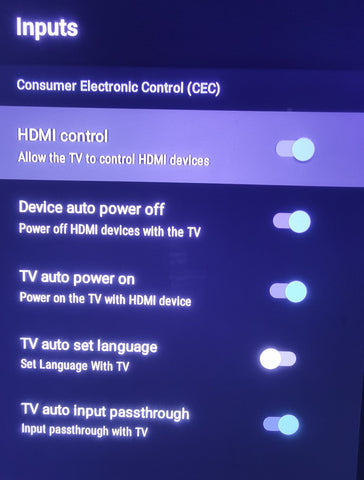
Mar 2024
0 Comments
MackTech Biz
Demystifying HDMI-CEC: Elevating Your Home Entertainment Experience
Welcome to the world of HDMI-CEC, the unsung hero of home entertainment setups. In this article, we'll discuss into what HDMI-CEC is, its evolution, how it works, its benefits, compatibility, troubleshooting tips, and future trends. By the end, you'll have a comprehensive understanding of this technology and how it can enhance your viewing experience. We will bring as well a simple guide to use HDMI-CEC for most major TV brands and steps on enabling it on Android TV Boxes and TV Sticks.
What is HDMI-CEC?
HDMI-CEC, or HDMI Consumer Electronics Control, is a feature embedded within HDMI cables that allows interconnected devices to communicate and control each other using a single remote. It simplifies the user experience by eliminating the need for multiple remotes and streamlining device management.
History and Evolution of HDMI-CEC:
HDMI-CEC has been an integral part of HDMI specifications since its inception, with each iteration refining its capabilities. Initially introduced to reduce remote control clutter, HDMI-CEC has evolved to offer enhanced functionality and compatibility across a wide range of devices.
How HDMI-CEC Works:
Through the CEC channel within HDMI cables, devices can send control commands to one another seamlessly. This enables actions such as turning devices on or off, adjusting volume levels, and switching inputs, all with a single remote.
Benefits of HDMI-CEC:
- Improved User Experience: Say goodbye to juggling multiple remotes. With HDMI-CEC, controlling your entire home entertainment system becomes a breeze.
- Simplified Setup: Gone are the days of complicated setup procedures. HDMI-CEC automates device configuration, making it easier than ever to get started.
- Enhanced Functionality: Customize your setup to suit your preferences. HDMI-CEC allows for automation of tasks and personalized configurations.
Compatible Devices and Limitations:
Most modern HDMI-enabled devices support HDMI-CEC to some extent. However, compatibility can vary between manufacturers and devices, leading to potential issues with certain setups.
How HDMI-CEC differs from HDMI-ARC:
Most modern HDMI-enabled devices support HDMI-CEC to some extent. It's important to note the distinction between HDMI-CEC and another HDMI feature called HDMI-ARC (Audio Return Channel). While HDMI-CEC focuses on device control and communication, HDMI-ARC enables audio to be sent from a TV to an external audio system, such as a soundbar or AV receiver, over the same HDMI cable used for video.
HDMI-ARC simplifies audio setup by eliminating the need for additional cables and allows for enhanced audio quality compared to traditional analog connections. However, it's essential to ensure that both the TV and the connected audio device support HDMI-ARC to take advantage of this feature fully.
Understanding the differences between HDMI-CEC and HDMI-ARC can help users leverage the full potential of their home entertainment systems and enjoy a seamless audiovisual experience.
Configuring HDMI-CEC on most brands:
Turning on HDMI-CEC is different for every TV brand. These steps are general guidelines for some common TV brands. The steps may vary from model to model or may change when TV software is updated.
If your TV brand isn't listed or the steps don't match, check your TV's user manual or online support pages for more information:
| Brand | HDMI CEC Name |
|---|---|
|
Anynet+ |
|
|
SIMPLINK |
|
|
BRAVIA Sync |
|
|
AQUOS Link |
|
|
CEC Control |
Samsung
HDMI-CEC:
- Press the Home button on your Samsung remote.
- Go to Settings on your device.
- Select System.
- Select Expert Settings.
- Select Anynet+ (HDMI-CEC).
- Select On.
Some TVs may use the following steps for HDMI-CEC:
- Press the Home button on your Samsung remote.
- Go to Settings on your device.
- Select General.
- Select External Device Manager.
- Select Anynet+ (HDMI-CEC).
- Select On.
LG
HDMI-CEC:
- Go to the settings menu. Press and hold the Settings button on your LG remote for 5 seconds.
- Select All Settings.
- Select General.
- Select SIMPLINK (HDMI-CEC).
- Set SIMPLINK (HDMI-CEC) to On.
Sony
HDMI CEC:
- Press the Home button on your Sony remote.
- Select Settings.
- Press OK.
- Select Watching TV.
- Select External inputs.
- Select BRAVIA Sync settings.
- Turn on BRAVIA Sync control.
Sharp
HDMI-CEC:
- Press the Menu button on your Sharp TV remote.
- Select System Options.
- Select AQUOS Link Setup.
- Set AQUOS Link Control to On.
Toshiba
HDMI-CEC:
- Press the Menu button on your Toshiba TV remote.
- Select Settings.
- Select System.
- Select HDMI & CEC Functions.
- Set CEC Control to On and detect the connected HDMI device.
Note: You need to turn on HDMI-CEC on the device connected to the TV to use its features.
Enable HDMI-CEC on Android TVs and TV Sticks/Boxes:
On Android TV Sticks and Boxes such as the TV Stick and Box, you can open Settings -> Device Preferences -> Inputs -> Consumer Electronic Control (CEC). Enable HDMI Control, Device Auto Power Off, TV Auto Power On, TV Auto Input Passthrough.

Troubleshooting and Tips:
Encountering issues with HDMI-CEC? Here are some tips:
- Ensure all devices are properly connected via HDMI.
- Check for firmware updates on your devices.
- Adjust settings in device menus to enable CEC functionality on both devices.
Future Trends and Developments:
As technology advances, HDMI-CEC is poised to evolve alongside it. Expect enhancements focused on improving compatibility, expanding functionality, and integrating with emerging technologies like voice control and smart home automation.
HDMI-CEC may not grab headlines, but its impact on the home entertainment landscape is profound. By simplifying setup procedures, enhancing functionality, and streamlining device control, HDMI-CEC transforms the way we interact with our entertainment systems for the better.

